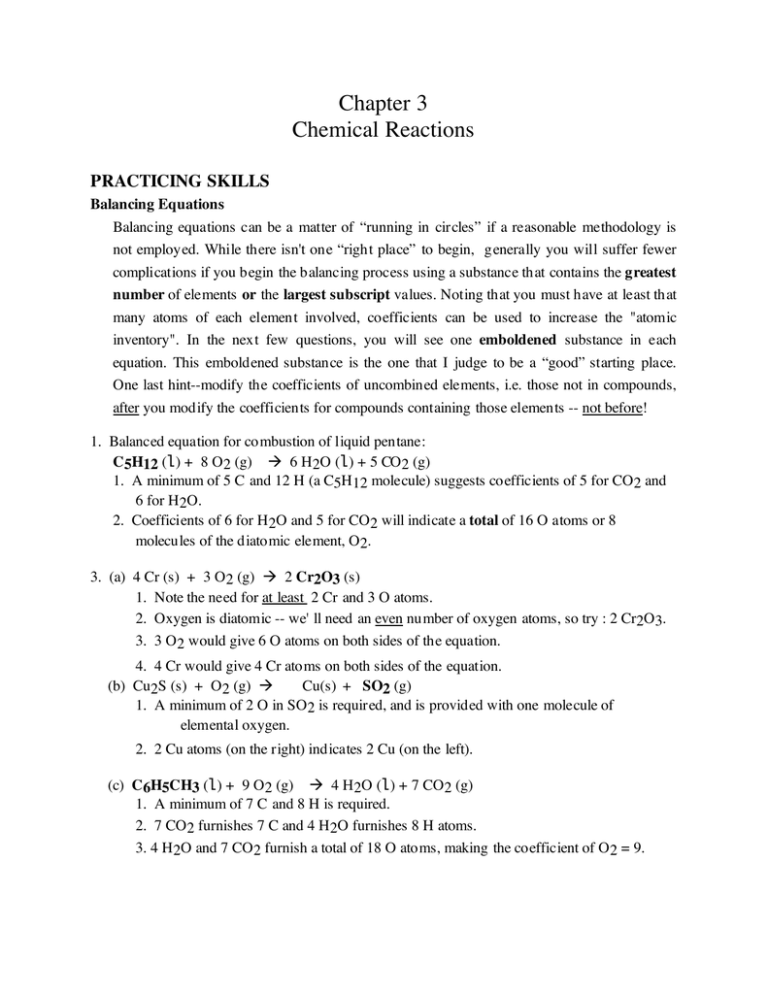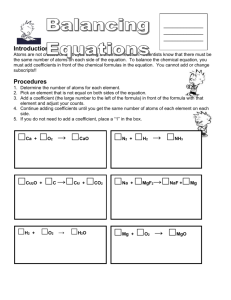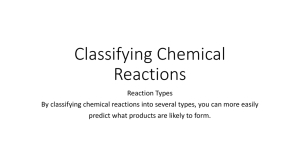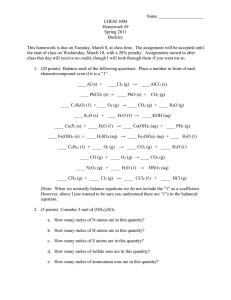Chapter 3 Chemical Reactions
advertisement

Chapter 3 Chemical Reactions PRACTICING SKILLS Balancing Equations Balancing equations can be a matter of “running in circles” if a reasonable methodology is not employed. While there isn't one “right place” to begin, generally you will suffer fewer complications if you begin the balancing process using a substance that contains the greatest number of elements or the largest subscript values. Noting that you must have at least that many atoms of each element involved, coefficients can be used to increase the "atomic inventory". In the next few questions, you will see one emboldened substance in each equation. This emboldened substance is the one that I judge to be a “good” starting place. One last hint--modify the coefficients of uncombined elements, i.e. those not in compounds, after you modify the coefficients for compounds containing those elements -- not before! 1. Balanced equation for combustion of liquid pentane: C5H12 (l) + 8 O2 (g) 6 H2O (l) + 5 CO2 (g) 1. A minimum of 5 C and 12 H (a C5H12 molecule) suggests coefficients of 5 for CO2 and 6 for H2O. 2. Coefficients of 6 for H2O and 5 for CO2 will indicate a total of 16 O atoms or 8 molecules of the diatomic element, O2. 3. (a) 4 Cr (s) + 3 O2 (g) 2 Cr2O3 (s) 1. Note the need for at least 2 Cr and 3 O atoms. 2. Oxygen is diatomic -- we' ll need an even number of oxygen atoms, so try : 2 Cr2O3. 3. 3 O2 would give 6 O atoms on both sides of the equation. 4. 4 Cr would give 4 Cr atoms on both sides of the equation. (b) Cu2S (s) + O2 (g) Cu(s) + SO2 (g) 1. A minimum of 2 O in SO2 is required, and is provided with one molecule of elemental oxygen. 2. 2 Cu atoms (on the right) indicates 2 Cu (on the left). (c) C6H5CH3 (l) + 9 O2 (g) 4 H2O (l) + 7 CO2 (g) 1. A minimum of 7 C and 8 H is required. 2. 7 CO2 furnishes 7 C and 4 H2O furnishes 8 H atoms. 3. 4 H2O and 7 CO2 furnish a total of 18 O atoms, making the coefficient of O2 = 9. Chapter 3 Chemical Reactions 5. Balance and name the reactants and products: (a) Fe2O3(s) + 3 Mg(s) 3 MgO(s) + 2 Fe(s) 1. Note the need for at least 2 Fe and 3 O atoms. 2. 2 Fe atoms would provide the proper iron atom inventory. 3. 3 MgO would give 3 O atoms on both sides of the equation. 4. 3 Mg would give 3 Mg atoms on both sides of the equation. Reactants: iron(III) oxide and magnesium Products: magnesium oxide and iron (b) AlCl3(s) + 3 NaOH(aq) Al(OH)3(s) + 3 NaCl(aq) 1. Note the need for at least 1 Al and 3 Cl atoms. 2. 3 NaCl molecules would provide the proper Cl atom inventory. 3. 3 NaCl would require 3 Na atoms on the left side—a coefficient of 3 for NaOH is needed. 4. 3 OH groups (from Al(OH)3) would give 3 OH groups needed on both sides of the equation—so a coefficient of 3 for NaOH is needed to provide that balance. Reactants: aluminum chloride and sodium hydroxide Products: aluminum hydroxide and sodium chloride. (c) 2 NaNO3(s) + H2SO4(l) Na2SO4(s) + 2 HNO3(l) 1. Note the need for at least 2 Na and 1 S and 4 O atoms. 2. 2 NaNO3 will provide the proper Na atom inventory. 3. The coefficient of 2 in front of NaNO3 requires a coefficient of 2 for HNO3— providing a balance for N atoms. 4. The implied coefficient of 1 for Na2SO4 suggests a similar coefficient for H2SO4—to balance the S atom inventory. 5. O atom inventory is done "automatically" when we balanced N and S inventories. Reactants: sodium nitrate and sulfuric acid Products: sodium sulfate and nitric acid [....although nitric acid typically exists as an aqueous solution.] (d) NiCO3(s) + 2 HNO3(aq) Ni(NO3)2(aq) + CO2(g) + H2O(l) 1. Note the need for at least 1 Ni atom on both sides. This inventory will mandate 2 NO3 groups on the right—and also on the left. Since these come from HNO3 molecules,we'll need 2 HNO3 on the left. 2. The 2 H from the acid and the CO3 from nickel carbonate, provide 2H, 1 C and 3 O atoms. 1 H2O takes care of the 2H, and one of the O atoms, 1 CO2 consumes the 1 C and the remaining 2 O atoms. Reactants: nickel(II) carbonate and nitric acid Products: nickel(II) nitrate, carbon dioxide, and water 40 Chapter 3 Chemical Reactions Chemical Equilibrium 7. The greater electrical conductivity of the HCl solution at equilibrium indicates a greater concentration of ions (H3 O+ and Cl- ), indicating that the HCl solution is more productfavored at equilibrium than the HCO2 H solution. Ions and Molecules in Aqueous Solution 9. What is an electrolyte? What are experimental means for discriminating between weak and strong electrolytes? An electrolyte is a substance whose aqueous solution conducts an electric current. As to experimental means for discriminating between weak and strong electrolytes, refer to the apparatus in the Active Figure5.2. NaCl is a strong electrolyte and would cause the bulb to glow brightly—reflecting a large number of ions in solution while aqueous ammonia or vinegar (an aqueous solution of acetic acid) would cause the bulb to glow only dimly— indicating a smaller number of ions in solution. 11. Predict water solubility: (a) CuCl2 is expected to be soluble, while CuO and FeCO3 are not. Chlorides are generally water soluble, while oxides and carbonates are not. (b) AgNO3 is soluble. AgI and Ag3PO4 are not soluble. Nitrate salts are soluble. Phosphate salts are generally insoluble. While halides are generally soluble, those of Ag+ are not. (c) K2CO3, KI and KMnO4 are soluble. In general, salts of the alkali metals are soluble. 13. Ions produced when the compounds dissolve in water. Compound Cation Anion + (a) KOH K OH(b) K2SO4 2 K+ SO42(c) LiNO3 Li+ NO3(d) (NH4)2SO4 2 NH4+ SO4215. Compound (a) Na2CO3 (b) CuSO4 (c) NiS (d) BaBr2 Water Soluble yes Cation 2 Na+ yes Cu2+ Anion CO32SO42- no yes Ba2+ 2 Br - 41 Chapter 3 Chemical Reactions Precipitation Reactions and Net Ionic Equations 17. CdCl2(aq) + 2 NaOH(aq) → Cd(OH)2(s) + 2 NaCl(aq) Net ionic equation: Cd2+(aq) + 2 OH-(aq) → Cd(OH)2(s) 19. Balanced equations for precipitation reactions: (a) NiCl2(aq) + (NH4)2S(aq) → NiS(s) + 2 NH4Cl(aq) Net ionic equation: Ni2+(aq) + S2-(aq) → NiS(s) (b) 3 Mn(NO3)2(aq) + 2 Na3PO4(aq) → Μn3(PO4)2(s) + 6 NaNO3(aq) Net ionic equation: 3 Mn2+(aq) + 2 PO43-(aq) → Μn3(PO4)2(s) Acids and Bases and Their Reactions 21. HNO3(aq) + H2O(Ú) → H3O+ (aq) + NO3-(aq) alternatively: HNO3(aq) → H+ (aq) + NO3-(aq) 23. H2C2O4(aq) → H+(aq) + HC2O4- (aq) HC2O4-(aq) → Η+(aq) + C2O42-(aq) 25. MgO(s) + H2O(l) → Mg(OH)2(s) (metal oxide reacts with water to form a base) 27. Complete and Balance (a) 2 CH3CO2H(aq) + Mg(OH)2(s) → Mg(CH3CO2)2(aq) + 2 H2O(l) acetic magnesium magnesium water acid hydroxide(base) acetate (b) HClO4(aq) + NH3(aq) → NH4ClO4(aq) perchloric ammonia ammonium acid (base) perchlorate 29. Write and balance the equation for barium hydroxide reacting with nitric acid: Ba(OH)2(s) + 2 HNO3(aq) → Ba(NO3)2(aq) + 2 H2O(Ú) barium nitric barium water hydroxide acid nitrate 31. Two strong Brönsted acids and one strong Brönsted base: Many examples exist: Strong acids: HCl, HBr, HI, HNO3 Strong bases: LiOH, NaOH, KOH 42 Chapter 3 Chemical Reactions Writing Net Ionic Equations 33. (a) (NH4)2CO3(aq) + Cu(NO3)2(aq) → CuCO3(s) + 2 NH4NO3(aq) (net) CO32-(aq) + Cu2+(aq) → CuCO3(s) (b) Pb(OH)2(s) + 2 HCl(aq) → PbCl2(s) + 2 H2O(l) (net) Pb(OH)2(s) + 2 H3O+(aq) + 2 Cl-(aq) → PbCl2(s) + 4 H2O(l) (c) BaCO3(s) + 2 HCl(aq) → BaCl2(aq) + H2O(l) + CO2(g) (net) BaCO3(s) + 2 H+(aq) → Ba2+(aq) + H2O(l) + CO2(g) alternatively: BaCO3(s) + 2 H3O+(aq) → Ba2+(aq) + 3 H2O(l) + CO2(g) (d) 2 CH3 CO2 H(aq) + Ni(OH)2 (s) → Ni(CH3 CO2 )2 (aq) + H2O(l) net: 2 CH3 CO2 H(aq) + Ni(OH)2 (s) → Ni2+(aq) + 2 CH3 CO2 - (aq) + 2 H2 O(l) 35. (a) AgNO3(aq) + KI(aq) → AgI(s) + KNO3(aq) (net) Ag+(aq) + I-(aq) → AgI(s) (b) Ba(OH)2(aq) + 2 HNO3(aq) → 2 H2O(l) + Ba(NO3)2(aq) (net) OH- (aq) + H3O+ (aq) → 2 H2O(l) (c) 2 Na3PO4(aq) + 3 Ni(NO3)2(aq) → Ni3(PO4)2(s) + 6 NaNO3(aq) (net) 2 PO43-(aq) + 3 Ni2+(aq) → Ni3(PO4)2(s) Gas-Forming Reactions 37. Write and balance the equation for iron(II) carbonate reacting with nitric acid: FeCO3(s) + 2 HNO3(aq) → Fe(NO3)2(aq) + H2O(l) + CO2(g) iron(II) nitric iron(II) water carbon carbonate acid nitrate dioxide 39. Overall, balanced equation for reaction of (NH4 )2 S with HBr: (NH4 )2 S + 2 HBr H2 S + 2 NH4 Br Ammonium Hydrogen Hydrogen Ammonium sulfide bromide sulfide bromide Oxidation Numbers 41. For questions on oxidation number, read the symbol (x) as “the oxidation number of x.” (a) BrO3(Br) + 3(O) = -1 Since oxygen almost always has an oxidation number of -2, we can substitute this value and solve for the oxidation number of Br. (Br) + 3(-2) = -1 (Br ) 43 = +5 Chapter 3 Chemical Reactions (b) C2O42- 2 (C) + 4 (O) = -2 2 (C) + 4 (-2) = -2 (c) F- 2 (C) + -8 = -2 2 (C) = +6 (C) = +3 The oxidation number for any monatomic ion is the charge on the ion. So (F) = -1 (d) CaH2 (e) H4SiO4 (Ca) + 2 (H) = 0 (Ca) + 2 (-1) = 0 (Ca) = +2 4(H) + (Si) + 4(O) = 0 4(+1) + (Si) + 4(-2) = 0 (Si) (f) HSO4- = +4 (H) + (S) + 4(O) = -1 (+1) + (S) + 4(-2) = -1 (S) = +6 Oxidation-Reduction Reactions 43. (a) Oxidation-Reduction: Zn(s) has an oxidation number of 0, while Zn2+(aq) has an oxidation number of +2—hence Zn is being oxidized. N in NO3- has an oxidation number of +5, while N in NO2 has an oxidation number of +4—hence N is being reduced. (b) Acid-Base reaction: There is no change in oxidation number for any of the elements in this reaction—hence it is NOT an oxidationreduction reaction. H2SO4 is an acid, and Zn(OH)2 acts as a base. (c) Oxidation-Reduction: Ca(s) has an oxidation number of 0, while Ca2+(aq) has an oxidation number of +2—hence Ca is being oxidized. H in H2O has an oxidation number of +1, while H in H2 has an oxidation number of 0—hence H is being reduced. 44 Chapter 3 Chemical Reactions 45. Determine which reactant is oxidized and which is reduced: (a) C2H4(g) + 3 O2(g) → 2 CO2(g) + 2 H2O(g) ox. number specie before after has experienced functions as the C -2 +4 oxidation (C2H4) reducing agent H +1 +1 no change O 0 -2 reduction (O2) oxidizing agent (b) Si(s) + 2 Cl2(g) → SiCl4(l) ox. number specie before after has experienced functions as the Si 0 +4 oxidation (Si) reducing agent Cl 0 -1 reduction (Cl2) oxidizing agent Types of Reactions in Aqueous Solution 47. Precipitation (PR), Acid-Base (AB), or Gas-Forming (GF) (a) Ba(OH)2(s) + 2 HCl(aq) → BaCl2(aq) + 2 H2O(l) (b) 2 HNO3(aq) + CoCO3(s) → Co(NO3)2(aq)+ H2O(l) + CO2(g) (c) 2 Na3PO4(aq) + 3 Cu(NO3)2(aq) → Cu3(PO4)2(s) + 6 NaNO3(aq) 49. Precipitation (PR), Acid-Base (AB), or Gas-Forming (GF) (a) MnCl2(aq) + Na2S(aq) → MnS(s) + 2 NaCl(aq) (net) Mn2+(aq) + S2-(aq) → MnS(s) (b) K2CO3(aq) + ZnCl2(aq) → ZnCO3(s) + 2 KCl(aq) (net) CO32-(aq) + Zn2+(aq) → ZnCO3(s) 51. Balance the following and classify them as PR, AB, GF, or OR: (a) CuCl2 (aq) + H2S(aq) CuS(s) + 2 HCl(aq) (b) H3PO4 (aq) + 3 KOH(aq) 3 H2O(l) + K3PO4(aq) (c) Ca(s) + 2 HBr(aq) H2(g) + CaBr2(aq) (d) MgCl2(aq) + H2O(l) 3 Mg(OH)2(s) + 2 HCl(aq) AB GF PR PR PR PR AB OR PR GENERAL QUESTIONS 53. Balance: (a) Synthesis of urea: CO2(g) + 2 NH3(g) CO(NH2)2(s) + H2O(l) 1. Note the need for two NH3 in each molecule of urea, so multiply NH3 by 2. 2. 2 NH3 provides the two H atoms for a molecule of H2O. 3. Each CO2 provides the O atom for a molecule of H2O. 45 Chapter 3 Chemical Reactions (b) synthesis of uranium(VI) fluoride UO2(s) + 4 HF(aq) UF4(s) + 2 H2O(l) UF4(s) + F2(g) UF6(s) 1. The 4 F atoms in UF4 requires 4 F atoms from HF. 2. The H atoms in HF produce 2 molecules of H2O. 3. The 1:1 stoichiometry of UF6 : UF4 provides a simple balance. (c) synthesis of titanium metal from TiO2: TiO2(s) + 2 Cl2(g) + 2 C(s) TiCl4(l) + 2 CO(g) TiCl4(l) + 2 Mg(s) Ti(s) + 2 MgCl2(s) 1. The O balance mandates 2 CO for each TiO2. (equation 1) (equation 1) (equation 2) (equation 1) 2. A coefficient of 2 for C provides C balance. (equation 1) 3. The Ti balance (TiO2:TiCl4) requires 4 Cl atoms, hence 2 Cl2 (equation 1) 4. The Cl balance requires 2 MgCl2, hence 2 Mg. (equation 2) 55. Formula for the following compounds: (a) soluble compound with Br- ion: almost any bromide compound with the exception of Ag+, Hg22+ and Pb2+ (b) insoluble hydroxide: almost any hydroxide except salts of NH4+ and the alkali metal ions (c) insoluble carbonate: almost any carbonate except salts of NH4+ and the alkali metal ions (d) soluble nitrate-containing compound: all nitrate-containing compounds are soluble The listing of soluble and insoluble compounds in your text will provide general guidelines for predicting the solubility of compounds. (e) a weak Bronsted acid: the carboxylic acids are weak acids: CH3CO2H (acetic) 57. For the following copper salts: Water soluble: Cu(NO3)2 , CuCl2 — nitrates and chlorides are soluble Water insoluble: CuCO3 , Cu3(PO4)2 — carbonates and phosphates are insoluble 59. Spectator ions in the following equation and the net ionic equation: 2 H3O+(aq) + 2 NO3-(aq) + Mg(OH)2(s) → 4 H2O(l) + Mg2+(aq) + 2 NO3-(aq) The emboldened nitrate ions are the spectator ions. The net ionic equation would be the first equation shown above without the spectator ions: 2 H3O+(aq) + Mg(OH)2(s) → 4 H2O(l) + Mg2+(aq) [An acid-base exchange] 46 Chapter 3 Chemical Reactions 61. For the reaction of chlorine with NaBr: Cl2(g) + 2 NaBr(aq) → 2 NaCl(aq) + Br2(l) (a) Oxidized: bromine’s oxidation number is changed from -1 to 0 Reduced: chlorine’s oxidation number is changed from 0 to –1 (b) Oxidizing agent: Cl2 removes the electrons from NaBr Reducing agent: NaBr provides the electrons to the chlorine. 63. Reaction: MgCO3(s) + 2 HCl(aq) CO2(g) + MgCl2(aq) + H2O(l) (a) The net ionic equation: MgCO3(s) + 2 H3O+ (aq) CO2(g) + Mg2+(aq) + 3 H2O(l) The spectator ion is the chloride ion (Cl-). (b) The production of CO2(g) characterizes this as a gas-forming reaction. 65. Species present in aqueous solutions of: compound types of species (a) NH3 molecules (weak base) (b) CH3CO2H molecules (weak acid) species present NH3, NH4+, OHCH3CO2H, CH3CO2-,H+ (c) NaOH ions (strong base) Na+ and OH(d) HBr ions (strong acid) H3O+ and BrIn every case, H2O will be present (but omitted in this list) 67. Balance and classify each as PR, AB, GF (a) K2CO3(aq) + 2 HClO4(aq) 2 KClO4(aq) + CO2(g) + 2 H2O(l) (b) FeCl2(aq) + (NH4)2S(aq) FeS(s) + 2 NH4Cl(aq) (c) Fe(NO3)2(aq) + Na2CO3(aq) FeCO3(s) + 2 NaNO3(aq) (d) 3 NaOH(aq) + FeCl3(aq) 3 NaCl(aq) + Fe(OH)3(s) GF PR PR PR IN THE LABORATORY 69. For the reaction: 2 NaI(s) + 2 H2SO4(aq) + MnO2(s) Na2SO4(aq) + MnSO4(aq) + I2 (g) + 2 H2O(l) (a) Oxidation number of each atom in the equation: (ox.numbers shown in order) Reactants: NaI (+1,-1) H2SO4 (+1, +6, -2) MnO2 (+4,-2) Products: Na2SO4 (+1,+6,-2) MnSO4 (+2,+6,-2) I2(0) H2O(+1,-2) (b) Oxidizing agent: MnO2 Oxidized: I in NaI Reducing agent: NaI Reduced: Mn (in MnO2) (c) The formation of gaseous iodine “drives” the process—product-favored 47 Chapter 3 Chemical Reactions (d) Names of reactants and products: H2SO4 MnO2 Na2SO4 NaI sodium sulfuric manganese(IV) sodium iodide acid oxide sulfate MnSO4 manganese(II) sulfate I2 iodine H2O water 71. Another way to prepare MgCl2 : Given the reactivity of both elemental magnesium and chlorine, one can bring the two elements into contact (carefully!) Mg(s) + Cl2 (g) MgCl2 (s) 73. In the reaction: C6H12O6 (aq) + 2 Ag+ (aq) + 2 OH- (aq) C6H12O7 (aq) + 2 Ag(s) + H2O(l) Oxidized: C6H12O6 is oxidized to C6H12O7 (simple observation—note that O is added) Reduced: Ag+(aq) is reduced to Ag(s) (oxidation number changes from +1 to 0) Oxidizing agent: Ag+ (aq) oxidizes the sugar Reducing agent: C6H12O6 reduces Ag+ SUMMARY AND CONCEPTUAL QUESTIONS 75. A simple experiment to prove that lactic acid is a weak acid (ionizing to a small extent) is to test the conductivity of the solution. A conductivity apparatus (e.g. a light bulb) will indicate only a small current flow (a light bulb will glow only dimly). To prove that the establishment of equilibrium is reversible, add strong acid (H3 O+). The shift of equilibrium to the left should result in the molecular acid precipitating from solution. 77. Using the reagents: BaCl2, BaCO3, Ba(OH)2, H2SO4, Na2SO4, Prepare barium sulfate by: a precipitation reaction The reaction of BaCl2 with Na2SO4 will perform this task: BaCl2 (aq) + Na2SO4(aq) BaSO4(s) + 2 NaCl (aq) a gas-forming reaction BaCO3(s) + H2SO4(l) BaSO4(s) + H2O(l) + CO2(g) One might think about using Ba(OH)2 as one reactant for part (a), but the substance isn’t very water-soluble. BaCl2 is much more water-soluble. 48





